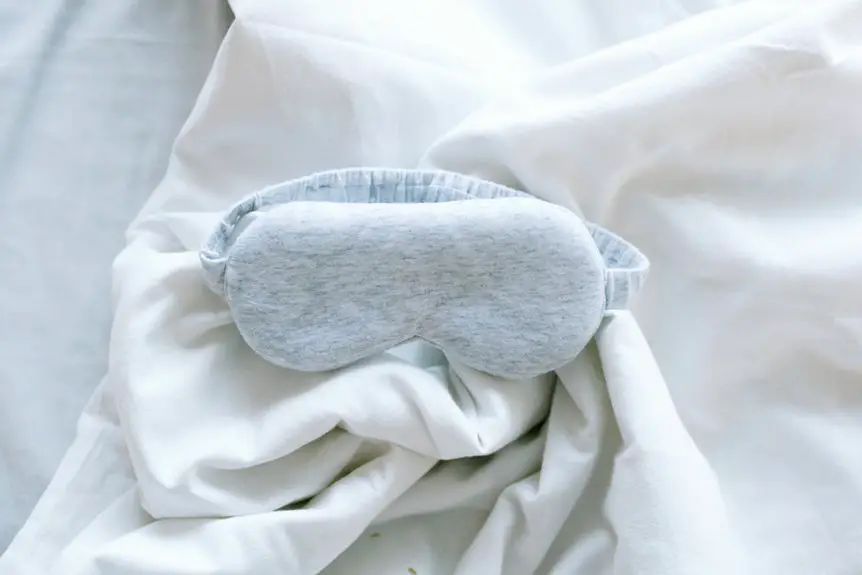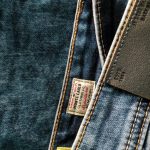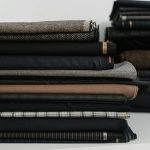You’ll find percale is a crisp, tightly woven fabric known for its smooth, matte finish and durability. Made mostly from cotton or cotton blends, it feels cool and breathable—perfect if you sleep warm or want long-lasting sheets that resist wrinkles and pilling. Its balanced one-over, one-under weave keeps the texture consistent, offering a fresh, clean touch every night. If you want to understand why percale stands out and how to care for it, keep exploring these key details.
Table of Contents
Key Takeaways
- Percale is a closely woven plain-weave fabric known for its crisp, smooth, and matte finish with a thread count typically between 200 and 400.
- Originally from Persia, percale became popular in Europe for its durability and fine quality, evolving from handwoven luxury to accessible textiles.
- It is commonly made from cotton, polyester, or blends, combining breathability, softness, strength, and wrinkle resistance.
- Percale bedding offers a cool, breathable feel ideal for warm climates, with durability that resists pilling, wrinkles, and frequent washing.
- Proper care includes gentle washing, low heat drying, and avoiding bleach to maintain the fabric’s crispness and extend its lifespan.
The Origin and History of Percale
Percale dates back several centuries, originating in Persia before spreading to Europe through trade routes. When you explore its history, you’ll find that percale was prized for its fine quality and durability.
Historically, it was handwoven with great care, making it a luxury item reserved for the elite. As trade expanded, percale’s reputation grew, reaching places like France and Italy, where artisans refined the production process.
You’ll notice that by the 18th century, percale became more accessible due to advancements in textile manufacturing.
Today, when you choose percale, you’re tapping into a rich tradition of craftsmanship that blends practicality with elegance, reflecting centuries of evolution from its Persian roots to global popularity.
Understanding the Percale Weave
You’ll want to start by understanding that percale is a simple, closely woven fabric made with a one-over, one-under weave pattern.
This structure gives percale its crisp feel and durability.
Plus, the thread count plays a big role in how smooth and breathable the fabric feels against your skin.
Definition of Percale Weave
A percale weave creates a crisp, tightly woven fabric by interlacing warp and weft threads one over, one under.
When you look closely, you’ll notice this plain weave forms a smooth, matte surface without any raised patterns. This simple interlacing technique guarantees the threads are packed closely, giving percale its distinctive firmness and durability.
You’ll find that percale typically uses a high thread count, often above 180, which enhances its strength and gives it that cool, breathable feel.
Because the weave is balanced, with equal numbers of vertical and horizontal threads, the fabric maintains consistent texture and weight.
When you choose percale, you’re opting for a fabric that’s both sturdy and comfortable, perfect for bedding and garments that last.
Weave Pattern Characteristics
When threads cross one over and one under in a precise, consistent manner, they create a tightly woven pattern that feels crisp and smooth to the touch. This is the hallmark of percale’s plain weave.
You’ll notice the fabric’s matte finish and cool, breathable texture come directly from this simple yet effective interlacing. The uniformity in the weave guarantees durability and a balanced strength, which means the fabric resists pilling and maintains its shape wash after wash.
Because the pattern is so consistent, percale drapes well without being heavy or stiff. When you run your fingers across percale sheets, you experience that signature clean, fresh feel — a direct result of the weave pattern working perfectly to combine comfort and longevity.
Thread Count Impact
Although percale’s weave plays an essential role in its texture, thread count considerably influences its overall quality and feel.
When you choose percale sheets, thread count typically ranges between 200 and 400. You might think higher thread count always means better quality, but with percale, a moderate count often delivers the best balance of breathability and durability.
If the count is too low, the fabric can feel rough or thin. Too high, and the sheets may lose percale’s signature crispness, becoming heavier and less breathable.
Common Materials Used in Percale Fabric
Percale fabric often combines different fibers to achieve its signature crispness and durability. You’ll mostly find percale made from cotton, polyester, or blends of both. Cotton offers breathability and softness, making it a favorite for comfort. Polyester adds strength and wrinkle resistance, helping sheets last longer and look fresh. Blended fabrics balance these benefits, giving you durability and ease of care without sacrificing feel.
Here’s a quick look at common materials in percale:
| Material | Feel | Benefits |
|---|---|---|
| Cotton | Soft, breathable | Natural, cool, comfortable |
| Polyester | Smooth, slightly slick | Durable, wrinkle-resistant |
| Cotton Blend | Balanced softness | Easy care, long-lasting |
Knowing these helps you pick percale that suits your sleep style perfectly.
Characteristics That Define Percale Sheets
When choosing percale sheets, you’ll want to focus on thread count, as it affects the fabric’s feel and durability.
The tight, one-over-one-under weave pattern gives percale its crisp texture and breathability.
Plus, the material composition plays a big role in how soft and long-lasting your sheets will be.
Thread Count Importance
Even if you’re new to bedding, you’ve probably heard that thread count matters, especially for percale sheets.
Thread count refers to the number of horizontal and vertical threads woven into one square inch of fabric. For percale, the ideal thread count usually falls between 200 and 400.
Here’s why it’s important for you:
- Breathability: A moderate thread count keeps percale crisp and cool, perfect for warm sleepers.
- Durability: Too low, and the fabric feels rough; too high, and it loses percale’s signature durability and breathability.
- Softness: The right thread count gives you that smooth, fresh feel night after night.
Choosing the right thread count guarantees you enjoy all the classic qualities percale offers.
Weave Pattern Details
Understanding thread count helps you appreciate why the weave pattern plays such an essential role in defining percale sheets.
Percale uses a simple, tight plain weave where one thread crosses over one thread, creating a crisp, matte finish. This balanced over-under pattern gives percale its signature durability and smooth texture.
You’ll notice the weave feels cooler and less slippery compared to sateen, ideal if you prefer breathable bedding. Since the threads are woven closely but not densely packed, percale sheets maintain good airflow, helping regulate your body temperature while you sleep.
You’ll also find that the weave enhances the fabric’s strength, meaning your percale sheets hold up well after many washes. This straightforward weave is what makes percale so popular for everyday comfort and lasting quality.
Material Composition Impact
Although the tight plain weave defines percale’s texture, the material composition plays an equally important role in its feel and durability. You’ll find that most percale sheets are made from cotton, but the type of cotton and any blends can change everything.
- Cotton Quality: Long-staple cotton, like Egyptian or Pima, gives you softer, stronger sheets that last through countless washes.
- Blends: Sometimes, percale is blended with polyester to boost wrinkle resistance and affordability, but it might lose some breathability.
- Organic Options: If you prefer natural fibers without chemicals, organic cotton percale offers a cleaner, eco-friendly choice that feels gentle on your skin.
Understanding these materials helps you pick percale sheets that match your comfort and lifestyle perfectly.
Benefits of Choosing Percale Bedding
When you choose percale bedding, you’ll enjoy a crisp, cool feel that’s perfect for warm nights.
Percale’s tight weave makes it breathable, helping you stay comfortable without overheating. You’ll appreciate how durable it is—percale holds up well to frequent washing, so your sheets look fresh and new longer.
The matte finish provides a smooth, soft texture that only gets better with time, offering a cozy yet lightweight experience. Plus, percale resists pilling and wrinkles, keeping your bed looking neat with minimal effort.
If you prefer a clean, classic look and want bedding that balances softness with durability, percale is a smart choice. It’s an investment in comfort that pays off every night.
How Percale Compares to Other Weaves
While you might be familiar with other bedding weaves like sateen or jersey, percale stands out for its crisp texture and breathable feel.
Unlike sateen, which is smooth and shiny, percale offers a matte finish and a cool, fresh touch that’s perfect if you tend to sleep hot.
Percale’s matte finish and cool feel make it ideal for those who sleep hot.
Jersey, on the other hand, feels more like a stretchy T-shirt—soft but less structured than percale.
Here’s why you might prefer percale:
- You crave that clean, crisp sensation every time you slip into bed.
- You want bedding that stays cool and comfortable through the night.
- You appreciate durability combined with a lightweight feel that lasts wash after wash.
Percale delivers all this with a classic, timeless appeal.
Tips for Caring for Percale Sheets
Caring for your percale sheets properly can extend their lifespan and keep that crisp feel you love.
Always wash them in cold or warm water using a gentle cycle to prevent shrinking and maintain fabric strength. Avoid using bleach or harsh detergents, as they can weaken fibers and dull the texture.
When drying, opt for a low heat setting or line dry to reduce wear and prevent wrinkles. Remove sheets promptly from the dryer to maintain their smoothness.
Ironing isn’t usually necessary, but if you prefer, use a low-heat setting.
Finally, store your percale sheets in a cool, dry place away from direct sunlight to prevent yellowing and fabric damage.
Following these tips will guarantee your percale sheets stay fresh, crisp, and comfortable for years.
Frequently Asked Questions
Can Percale Fabric Be Used for Clothing?
You can definitely use percale fabric for clothing. It’s lightweight, breathable, and has a crisp feel that’s perfect for shirts or dresses. Just remember, its durability makes it great for everyday wear too.
Is Percale Fabric Hypoallergenic?
You won’t wake up sneezing like you’ve walked through a field of flowers—percale fabric’s tightly woven cotton keeps allergens at bay. You’ll love how it feels soft, breathable, and gentle on sensitive skin all night long.
How Does Percale Fabric Perform in Humid Climates?
You’ll find percale fabric performs well in humid climates because it’s breathable and lightweight, allowing air to circulate and moisture to evaporate quickly. This helps you stay cool and comfortable, even on sticky, humid nights.
Are Percale Sheets Suitable for People With Sensitive Skin?
Oh sure, if you love a fabric that’s as gentle as a cloud and won’t irritate your skin, you’ll adore percale sheets. They’re crisp, breathable, and perfect for sensitive skin—no drama included!
Can Percale Fabric Be Dyed Easily?
You can dye percale fabric easily because it’s usually made of cotton, which absorbs dye well. Just make sure to use the right dye type and follow instructions to get vibrant, even colors without damaging the fabric.
- Does Chiffon Fabric Stink - July 15, 2025
- Does Chiffon Fabric Affect the Economy - July 15, 2025
- Does Cotton Fabric Have a Nap - July 15, 2025







